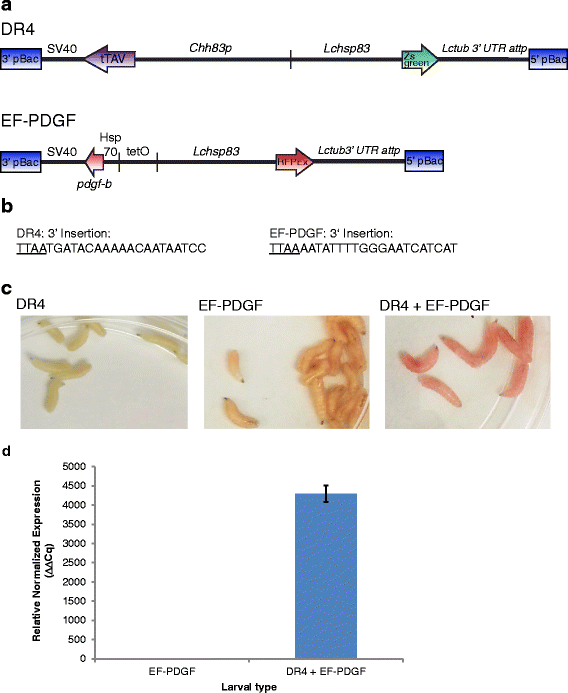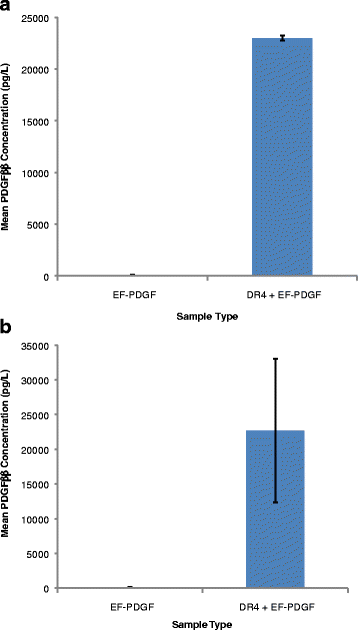Towards next generation maggot debridement therapy: transgenic Lucilia sericata larvae that produce and secrete a human growth factor
- PMID: 27006073
- PMCID: PMC4804476
- DOI: 10.1186/s12896-016-0263-z
Towards next generation maggot debridement therapy: transgenic Lucilia sericata larvae that produce and secrete a human growth factor
Abstract
Background: Diabetes and its concurrent complications impact a significant proportion of the population of the US and create a large financial burden on the American health care system. FDA-approved maggot debridement therapy (MDT), the application of sterile laboratory-reared Lucilia sericata (green bottle fly) larvae to wounds, is a cost-effective and successful treatment for diabetic foot ulcers and other medical conditions. Human platelet derived growth factor-BB (PDGF-BB) is a secreted dimeric peptide growth factor that binds the PDGF receptor. PDGF-BB stimulates cell proliferation and survival, promotes wound healing, and has been investigated as a possible topical treatment for non-healing wounds. Genetic engineering has allowed for expression and secretion of human growth factors and other proteins in transgenic insects. Here, we present a novel concept in MDT technology that combines the established benefits of MDT with the power of genetic engineering to promote healing. The focus of this study is to create and characterize strains of transgenic L. sericata that express and secrete PDGF-BB at detectable levels in adult hemolymph, whole larval lysate, and maggot excretions/ secretions (ES), with potential for clinical utility in wound healing.
Results: We have engineered and confirmed transgene insertion in several strains of L. sericata that express human PDGF-BB. Using a heat-inducible promoter to control the pdgf-b gene, pdgf-b mRNA was detected via semi-quantitative PCR upon heat shock. PDGF-BB protein was also detectable in larval lysates and adult hemolymph but not larval ES. An alternative, tetracycline-repressible pdgf-b system mediated expression of pdgf-b mRNA when maggots were raised on diet that lacked tetracycline. Further, PDGF-BB protein was readily detected in whole larval lysate as well as larval ES.
Conclusions: Here we show robust, inducible expression and production of human PDGF-BB protein from two conditional expression systems in transgenic L. sericata larvae. The tetracycline-repressible system appears to be the most promising as PDGF-BB protein was detectable in larval ES following induction. Our system could potentially be used to deliver a variety of growth factors and anti-microbial peptides to the wound environment with the aim of enhancing wound healing, thereby improving patient outcome in a cost-effective manner.
Keywords: Diabetic foot ulcer; Excretions/secretions (ES); Growth factor treatment; Lucilia sericata; Maggot debridement therapy (MDT); Platelet-derived growth factor (PDGF); Tetracycline transactivator; Wound healing.
Figures




Similar articles
-
[Mechanism of maggot debridement therapy in promoting wound angiogenesis in patients with diabetic foot ulcer].Zhonghua Shao Shang Za Zhi. 2020 Nov 20;36(11):1040-1049. doi: 10.3760/cma.j.cn501120-20191022-00409. Zhonghua Shao Shang Za Zhi. 2020. PMID: 33238687 Chinese.
-
A molecular approach to maggot debridement therapy with Lucilia sericata and its excretions/secretions in wound healing.Wound Repair Regen. 2021 Nov;29(6):1051-1061. doi: 10.1111/wrr.12961. Epub 2021 Aug 3. Wound Repair Regen. 2021. PMID: 34343386
-
Anti Leishmania activity of Lucilia sericata and Calliphora vicina maggots in laboratory models.Exp Parasitol. 2016 Nov;170:59-65. doi: 10.1016/j.exppara.2016.08.007. Epub 2016 Aug 24. Exp Parasitol. 2016. PMID: 27567983
-
Clinical applications for maggots in wound care.Am J Clin Dermatol. 2001;2(4):219-27. doi: 10.2165/00128071-200102040-00003. Am J Clin Dermatol. 2001. PMID: 11705249 Review.
-
[Maggot therapy in wound management].Tidsskr Nor Laegeforen. 2009 Sep 24;129(18):1864-7. doi: 10.4045/tidsskr.08.0656. Tidsskr Nor Laegeforen. 2009. PMID: 19844278 Review. Norwegian.
Cited by
-
Effectiveness of Chronic Wound Debridement with the Use of Larvae of Lucilia Sericata.J Clin Med. 2019 Nov 2;8(11):1845. doi: 10.3390/jcm8111845. J Clin Med. 2019. PMID: 31684038 Free PMC article. Review.
-
A human tissue-based assay identifies a novel carrion blowfly strain for maggot debridement therapy.Sci Rep. 2022 Jul 16;12(1):12191. doi: 10.1038/s41598-022-16253-9. Sci Rep. 2022. PMID: 35842442 Free PMC article.
-
Building early-larval sexing systems for genetic control of the Australian sheep blow fly Lucilia cuprina using two constitutive promoters.Sci Rep. 2017 May 31;7(1):2538. doi: 10.1038/s41598-017-02763-4. Sci Rep. 2017. PMID: 28566730 Free PMC article.
-
Building a transgenic sexing strain for genetic control of the Australian sheep blow fly Lucilia cuprina using two lethal effectors.BMC Genet. 2020 Dec 18;21(Suppl 2):141. doi: 10.1186/s12863-020-00947-y. BMC Genet. 2020. PMID: 33339506 Free PMC article.
-
Mesenchymal Stem Cells Improve Healing of Diabetic Foot Ulcer.J Diabetes Res. 2017;2017:9328347. doi: 10.1155/2017/9328347. Epub 2017 Mar 12. J Diabetes Res. 2017. PMID: 28386568 Free PMC article. Review.
References
-
- Thomas S, Jones M. Wound debridement: evaluating the costs. Nurs Stand. 2001;15(22):59–61. - PubMed
-
- Chan DC, Fong DH, Leung JY, Patil NG, Leung GK. Maggot debridement therapy in chronic wound care. Hong Kong Med J. 2007;13(5):382–6. - PubMed
-
- Sherman RA, Mumcuoglu KY, Grassberger M, Tantawi TI. Maggot therapy. In: Grassberger M, Sherman RA, Gileva OS, Kim CMH, Mumcuoglu KY, editors. Biotherapy - history, principles and practice: a practical guide to the diagnosis and treatment of disease using living organisms. Dordrecht: Springer; 2013. pp. 5–29.
Publication types
MeSH terms
Substances
LinkOut - more resources
Full Text Sources
Other Literature Sources

